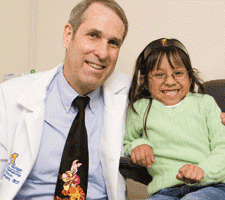
Dr. Steven Archer a patient
How are parents to know when an infant or child has a serious eye problem? Pediatric ophthalmologist Steven M. Archer, M.D., has been treating babies and youngsters at the U-M Kellogg Eye Center for more than 20 years. He has identified three red flags that should alert parents to a possible problem with their child’s vision.
- Your child’s pupil looks “different” in a photograph taken with a flash.
It is normal to see “red eye” in a photograph taken with a flash. If, however, the eye appears to be white, a trip to a pediatric ophthalmologist is in order. In some cases, the white pupil could signal a cataract or even retinoblastoma, a cancer of the eye. Or that odd-looking pupil in the photo might be caused by eyes that have unequal refractive errors. These problems can and should be evaluated and treated without delay.- Cataracts in babies under two must be treated urgently with cataract removal and contact lens correction to give the child an opportunity to develop vision in the eye. Cataracts in older children are treated the same as they are in adults, with surgery and placement of an intraocular lens.
- Retinoblastoma is a life-threatening problem and must be treated immediately. Although rare, retinoblastoma is the most common malignant childhood ocular tumor. The earlier it is detected, the more likely it is to treat successfully. Treatment depends on the size of the tumor.
- Eyes that focus differently can also cause vision loss. If, as a child grows, the image in one eye is not in focus, the brain can lose the ability to interpret images from that eye. This is called amblyopia, a fairly common condition that is preventable and reversible. There are several treatments; success is linked to early detection.
- Your child’s eyes are crossed or otherwise not aligned properly.The alignment of a baby’s eyes usually becomes stable at 4-6 months. After that, if they are not aligned, the baby should be examined by a pediatric ophthalmologist.This misalignment, called strabismus, affects about 4% of children. As above, if a child’s eyes are misaligned and can be used only one at a time, the result can be amblyopia. Strabismus is correctable through a variety of treatments, including surgery.
- Your child holds books and objects close to the eyes when playing.By approximately 18 months of age, a toddler’s vision is fairly mature. If your child consistently holds books and toys especially close to his or her eyes, you have reason to suspect that vision is not developing properly. Many things can cause a child’s vision to be impeded. For instance, your toddler could be nearsighted. In this case glasses will be prescribed to correct the refraction and allow him or her to see clearly.
Find a Doctor or Clinic Location
- Find a doctor
- Find a location
- Call 734-764-7558
